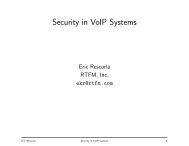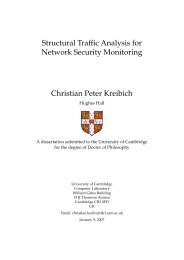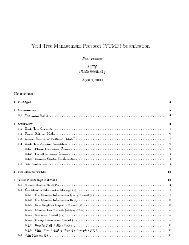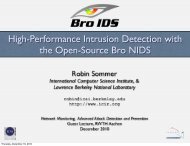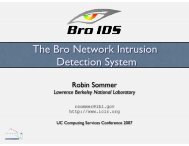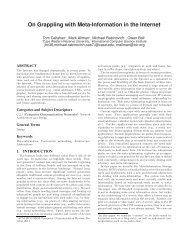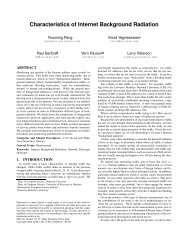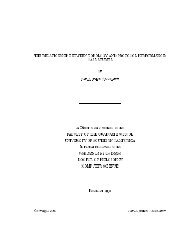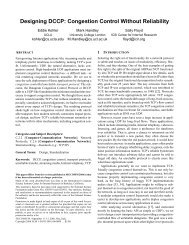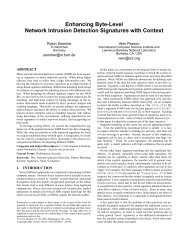SIFF: A Stateless Internet Flow Filter to Mitigate DDoS Flooding Attacks
SIFF: A Stateless Internet Flow Filter to Mitigate DDoS Flooding Attacks
SIFF: A Stateless Internet Flow Filter to Mitigate DDoS Flooding Attacks
Create successful ePaper yourself
Turn your PDF publications into a flip-book with our unique Google optimized e-Paper software.
• Backward Compatibility. Legacy clients and servers<br />
do not break <strong>SIFF</strong>, and legacy clients can communicate<br />
with updated servers and vice versa. However, both<br />
clients and servers must be updated <strong>to</strong> take advantage<br />
of the system’s benefits.<br />
To construct a system with these properties, we begin<br />
with the following assumptions, some of which we use for<br />
simplicity of presentation and will relax or remove in Section<br />
5.2.<br />
We first assume that a victim has the ability <strong>to</strong> determine<br />
that it is under attack, and can differentiate between legitimate<br />
client flows and malicious or misbehaving flows. We<br />
do not require that this differentiation be on a per-packet basis,<br />
or that it be lightweight; only that it exist. 1 However,<br />
the details of a traffic differentiation algorithm are application<br />
specific and orthogonal <strong>to</strong> the focus of this paper, which<br />
simply assumes their existence.<br />
Secondly, we assume that clients, servers and routers<br />
are redesigned and conform <strong>to</strong> a modified IP network layer<br />
(non-updated clients and servers will still be able <strong>to</strong> communicate<br />
with updated clients and servers, but they will not<br />
realize the benefits of the new system). Specifically:<br />
• Marking space in the IP header. We assume that the<br />
IP header has sufficient space <strong>to</strong> accommodate the information<br />
that routers mark in the packet.<br />
• Routers mark every packet. We assume that <strong>SIFF</strong><br />
routers are capable of executing minor manipulations<br />
of the marking field of every packet that they forward.<br />
These manipulations can be done in parallel with a<br />
routing table lookup. This assumption is minor, since<br />
<strong>Internet</strong> routers must already decrement the TTL and<br />
recalculate the IP Header Checksum of every packet<br />
they forward.<br />
• Short-term Route Stability. We assume that <strong>Internet</strong><br />
routes are stable on the order of the time of a<br />
client/server transaction. Violation of this assumption<br />
will not break our system outright, rather, the system’s<br />
performance is likely <strong>to</strong> decrease with increasing route<br />
instability below the time required for a client/server<br />
transaction. Network routes are more likely <strong>to</strong> fluctuate<br />
under <strong>DDoS</strong> attack, precisely when our system<br />
requires their stability. However, <strong>SIFF</strong> will also mitigate<br />
the effect of <strong>DDoS</strong> on routers (as packet floods<br />
are dropped early in the network), and is, in this way,<br />
self-reinforcing. Unfortunately, it is difficult <strong>to</strong> model<br />
the behavior of a system as complex as the <strong>Internet</strong>,<br />
especially under <strong>DDoS</strong> attack, so verification of this<br />
assumption is an open problem.<br />
1 Because our mechanism limits source address spoofing, it can make<br />
malicious host identification easier.<br />
Our approach divides all <strong>Internet</strong> traffic in<strong>to</strong> two types,<br />
privileged and unprivileged. Privileged packets are always<br />
given priority over non-privileged ones when contending<br />
for bandwidth. To establish a privileged channel, a client<br />
must obtain a capability through a special handshake over<br />
an unprivileged channel. Privileged channels consist of specially<br />
marked packets embedded with the capability obtained<br />
through the unprivileged handshake.<br />
The capabilities in <strong>SIFF</strong> are based on information inserted<br />
in<strong>to</strong> all packets by the network en route <strong>to</strong> their destinations.<br />
This mechanism is similar <strong>to</strong> that of P i, proposed<br />
by us in an earlier paper [47], except that in <strong>SIFF</strong>, the computation<br />
process for markings is slightly more elaborate, as<br />
packet markings change over time (as opposed <strong>to</strong> remaining<br />
constant in P i), and are used by both routers and endhosts,<br />
rather than just by endhosts. The capability is generated<br />
piecemeal by each router and marked in a field of the packet<br />
along the path <strong>to</strong> the packet’s destination. The pieces at<br />
each router are generated entirely from packet header data<br />
and local <strong>to</strong>pology information.<br />
<strong>SIFF</strong> provides the above benefits <strong>to</strong> the receiver of a privileged<br />
channel. When forwarding a privileged packet, a<br />
router simply checks part of the embedded capability <strong>to</strong> see<br />
if it matches the markings that the router would have added<br />
<strong>to</strong> an unprivileged packet—if they match, then the packet is<br />
forwarded; if they do not, then the packet is dropped. The<br />
capabilities themselves are based on the packet markings,<br />
which change independently at each router with a certain<br />
frequency. Routers maintain a window of valid markings<br />
and signal a change of marking <strong>to</strong> a packet recipient by replacing<br />
old markings in the embedded capability with new<br />
ones. Because the packet recipient, rather than the packet’s<br />
sender, is receiving the capability updates, continued privileged<br />
communication requires that the receiver periodically<br />
update the sender’s capability. Thus, the receiver of a packet<br />
flow has the option <strong>to</strong> halt that flow by simply refusing <strong>to</strong><br />
forward capability updates. Attackers can still flood using<br />
unprivileged packets, but they will no longer disrupt existing<br />
privileged communications. Furthermore, during an<br />
unprivileged flooding attack, a legitimate client and server<br />
need only pass two packets (a <strong>to</strong>tal of one round trip) between<br />
themselves <strong>to</strong> establish a privileged channel and communicate,<br />
undisturbed, over privileged packets.<br />
3 Design<br />
The <strong>SIFF</strong> system provides a server with the ability <strong>to</strong><br />
establish privileged communication with whatever clients it<br />
chooses by providing those clients with a capability <strong>to</strong>ken. 2<br />
2 For ease of presentation, we refer <strong>to</strong> a flow’s source as the client and a<br />
flow’s destination as the server. This does not mean that privileged channels<br />
can only be established from clients <strong>to</strong> servers.<br />
4




